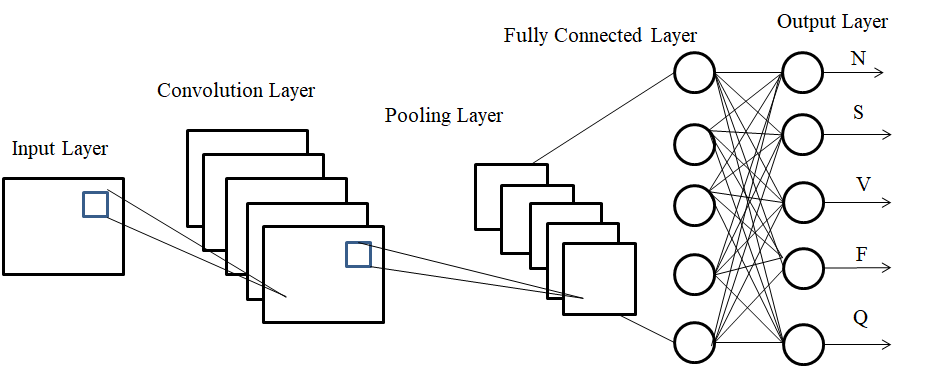Deep Learning Frameworks for Cardiovascular Arrhythmia Classification
Main Article Content
Abstract
Arrhythmia classification is a prominent research problem due to the computational complexities of learning the morphology of various ECG patterns and its wide prevalence in the medical field, particularly during the COVID-19 pandemic. In this article, we used Empirical Mode Decomposition and Discrete Wavelet Transform for preprocessing and then the modified signal is classified using various classifiers such as Decision Tree, Logistic Regression, Gaussian Naïve Bayes, Random Forest, Linear SVM, Polynomial SVM, RBF SVM, Sigmoid SVM and Convolutional Neural Networks. The proposed method classify the data into five classes N (Normal), S (Supraventricular premature) beat, (V) Premature ventricular contraction, F (Fusion of ventricular and normal), and Q, (Unclassifiable Beat) using softmax regressor at the end of the network. The proposed approach performs well in terms of classification accuracy when tested using ECG signals acquired from the MIT-BIH database. In comparison to existing classifiers, the Accuracy, Precision, Recall, and F1 score values of the proposed technique are 98.5%, 96.9%, 94.3%, and 91.32%, respectively.
Article Details
References
N.I.Hasan, Bhattacharjee, A, “Deep learning approach to cardiovascular disease classification employing modified ECG signal from EMD,” Bio Sig Proc and Con, vol. 52, pp.128-140, 2019.
E. Zahra, L. Mohammad, D. Masoud and G. Arash, “A Review on Deep Learning Methods for ECG Arrhythmia Classification,” Expert Systems with Applications: X, 2020.
U.R.Acharya, F.Hamido, L.O.Shu, H.Yuki, H.T.Jen and A. Muhammad, “Application of deep CNN for automated detection of myocardial infarction using ECG signals,” Information Sciences, 190–198, 2017.
X. Xuexiang and L.Hongxing, “ECG Heartbeat Classification Using Convolutional Neural Networks, IEEE Access, 2017.
B.Pyakillya, N. Kazachenko and N.Mikhailovsky, “Deep Learning for ECG Classification, IOP Conf. Series 913, 2017.
U. Amin, S.M.Anwar, M.Bilal and M.M.Raja, “Classification of Arrhythmia by Using Deep Learning with 2-D ECG Spectral Image Representation, Remote sensing, 12,1685, 2020.
Ridhi, S., Namita, B., & Puneet, B, “Classification of heart diseases from ECG signals using WT and kNN classifier,” ICCCA 2015, pp.1208-1215, 2015.
Dhawal Khem, Shailesh Panchal, Chetan Bhatt. (2023). An Overview of Text Translation and Text Simplification Tasks. International Journal of Intelligent Systems and Applications in Engineering, 11(3s), 329–336. Retrieved from https://ijisae.org/index.php/IJISAE/article/view/2701
N.Alajlan, Y.Bazi, F.Melgani, S. Malek, and M.A.Bencherif, “Detection of premature ventricular contraction arrhythmias in electrocardiogram signals with kernel methods,” Signal, Image and Video Processing, Vol.8, no.5, pp. 931-942, 2014.
Taiyong, L., & Min, Z, “ECG classification using WPT entropy and Random forests. Entropy”, 18, pp.1-16, 2016.
Manisha., Sanjeev, K.S.,& Krishna, K, “ECG beat classifiers: A journey from ANN to DNN,” Proc Comput Sci, Vol.167, pp.747-759, 2020.
G. K. Malik, Y. Kumar, and M.Panda, “Cardiac arrhythmia detection in ECG signals by feature Extraction and support vector machine,” ACSIS, Vol. 10, pp. 241–244, 2016.
R. Banerjee, A. Ghose, S. Khandelwal, “ A Novel Recurrent Neural Network Architecture for Classification of Atrial Fibrillation Using Single-lead ECG,” European Signal Processing Conference (EUSIPCO), pp. 1-5, IEEE.
R. J. Martis, U. R. Acharya, K.M. Mandana, A.K. Ray, and Ch.Chakraborty, “Cardiac decision making using higher-order spectra,” Biomedical Signal Processing and Control, Vol.8, no.2, pp.193-203, 2013.
R. Karthik, D.Tyagi,A. Raut, S. Saxena, K.P.Bharath, and M.Rajesh Kumar, “ Implementation of neural network and feature extraction to classify ECG signals,” In Microelectronics, Electromagnetics and Telecommunications, pp. 317-326, 2019.
Dr. Sandip Kadam. (2014). An Experimental Analysis on performance of Content Management Tools in an Organization. International Journal of New Practices in Management and Engineering, 3(02), 01 - 07. Retrieved from http://ijnpme.org/index.php/IJNPME/article/view/27
H.Runnan, Y.Liu, K.Wang, N. Zhao, Y.Yuan, Q. Li, Q, &and H.Zhang, “Automatic cardiac arrhythmia classification using a combination of deep residual network and bidirectional LSTM,” IEEE Access, Vol.7, pp.102119-102135.
Darmawahyuni, S. Nurmaini, M.N. Rachmatullah, M. N, F. Firdaus, and B. Tutuko, “Unidirectional-bidirectional recurrent networks for cardiac disorders classification,” Telkomnika, Vol.19, no.3, pp. 902-910.
I.N.Yulita, M.I.Fanany, and A.M.Arymuthy, “Bi-directional long short-term memory using quantized data of deep belief networks for sleep stage classification,” Procedia computer science, Vol.116, pp.530-538, 2017.
Y. Lecun, L. Bottou, Y. Bengio, and P. Haffner, ‘‘Gradient-based learning applied to document recognition,’’ Proc. IEEE, vol. 86, no. 11, pp. 2278–2324, Nov. 1998.
Juan Garcia, Guðmundsdóttir Anna, Johansson Anna, Maria Jansen, Anna Wagner. Machine Learning for Predictive Maintenance and Decision Making in Manufacturing. Kuwait Journal of Machine Learning, 2(4). Retrieved from http://kuwaitjournals.com/index.php/kjml/article/view/212
Y. LeCun and Yoshua Bengio, ‘‘Convolutional networks for images, speech, and time series,’’ in The Handbook of Brain Theory and Neural Networks, vol. 3361, no. 10. Cambridge, MA, USA: MIT Press, 1995, p. 1995.
http://www.physionet.org/physiobank/database/mitdb: The MIT-BIH Arrhythmia Database.

